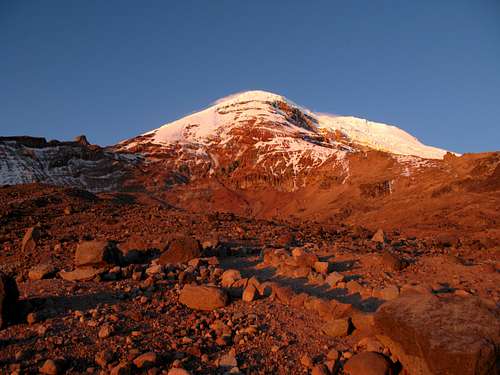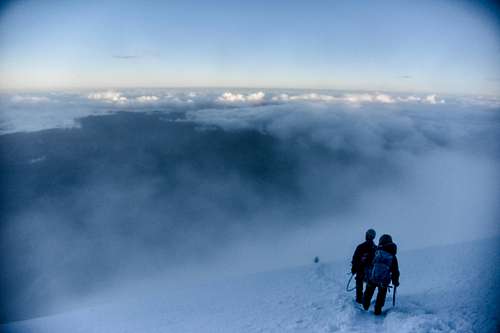-
 2691 Hits
2691 Hits
-
 70.36% Score
70.36% Score
-
 1 Votes
1 Votes
|
|
Trip Report |
|---|---|
|
|
Nov 30, 0000 |
|
|
Mountaineering |
|
|
Summer |
On July 10th, 2016, with my guide, Fabian,
I summited Cumber de Whymper (The Whymper Summit), the highest point on Chimborazo.
Altogether, there were two other pairs, Juan Carlos of Cali, Colombia and Shaun
of Taiwan, with their respective guide. All of us climbed with Andean
Adventures, headed by John, who also operated and managed the two refuges on Chimborazo:
Refugio Carrel (4,850 meters above the sea level) and Refugio Whymper (5,000
meters, which is the highest lodging in Ecuador). I found John and his
mountaineering company through internet. After some protracted rainy season
driven by El Niño in June, there was a window of
opportunity to climb Chimborazo over the July 9-10 weekend. On Thursday
preceding the summit weekend, John responded to my inquiry by email and offered
an extra night of accommodation in Refugio Carrel for Friday so that I could
acclimatize better and climb Saturday night. I traveled to Riobamba from Cuenca
by bus. John came to the bus terminal to meet me. Then he took me to his office
near the bus terminal and had me try the boots and other gear. Afterwards, I
left my unnecessary luggage in John’s office and went up Chimborazo in John’s
SUV. The drive from John’s office to Refugio Carrel was about one hour. John
made several stops on the way to get groceries for his kitchen in the refuge.
He purchased his supplies exclusively from the indigenous community to promote the
local economy and to provide his customers with fresh produce. We even stopped at
a diary place to get some fresh milk of the day. John also kindly stopped at
least three times on the way up for me to take pictures of Chimborazo and
introduced me to flora and fauna on the mountain including vicuñas, a beautiful deer-like animal.
Refugio Carrel was very comfortable
with good cushion. The food was delicious with soup, meat, bread, dessert, and
beverage. In the cafeteria, I met my guide Fabian, who was John’s right-hand
person on the mountain. Since John ran the two refuges on Chimborazo, he had his
mountain guides up there 24/7 to deal with any climbing-related emergencies and
contingencies. Compared with other mountaineering services, many of which
operated out of Quito, John’s team had the home advantage for Chimborazo, since
his guides are on the mountain all the time, really know Chimborazo, and are
up-to-date with the weather conditions there. In order to help me with
acclimatization, John told me to walk up to Refugio Whymper and from there to
the Condor Chocha Lagoon at 5,100 meters above the sea level. After a good
sleep on Friday night, I rested during Saturday. Then after dinner at 5PM, we
moved to Refugio Whymper in order to start climbing around 10pm Saturday. My
effort to have a couple of hours of sleep was futile as I remained sleepless
and anxious about the climb. Around 10:20pm, the six of us left Refugio Whymper.
We used the El Castillo rout on the
west side of Chimborazo, which normally takes eight to twelve hours to ascend
and about three to five hours to descend. The route starts at Refugio Whymper
to a saddle above El Castillo. From the saddle, there is a glacier ridge leading
to the Veintemilla Summit at 6,267-meters
(20,561 ft). We went up the trail to the left of Refugio Whymper, passed the lagoon
and a short flat beyond. Then we climbed up a rocky area, which was a dangerous
zone during the daytime when the warmth of the day might dislodge the rocks. It
was to avoid this danger and avalanche that climbs on Chimborazo start close to
midnight so that climbers could return early enough to pass the rocky zone on
the descent and to avoid potential risks of avalanches during the day when it
gets warmer. After the rocky area, we traversed a terrain of mixture of
gravels, snow, and ice. Then we put on the crampons and ascended the
snow-covered slope toward Veintemilla. On November 10, 1993, three parties, two
descending and one ascending, were on the steep snow slopes below Veintemilla
when the slopes yielded to an avalanche, burying and killing all ten
climbers—six French, two Ecuadorans, one Swiss, and one Chilean.
On the way up, we took three breaks
to gather our strength and take nutrition. Fabian and I reached the cumber de Veintemilla
around 5:40am, which was the second highest peak on Chimborazo. Many climbers
stopped here and returned without going to the Whymper Summit, 43 meters taller
than Veintemilla, because of weather conditions or lack of energy. At Veintemilla,
the wind was not strong, though snowflakes were swirling. My glasses were
covered with a layer of snow. Fabian decided to take me to Whymper. The
distance between Veintemilla and Whymper was about one mile. We first descended
to a trough from Veintemilla and went up a steep slope before reaching the real
summit of Chimborazo at 5:10am. After seven hours and fifty minutes, we stood
at an elevation of 6,310 m (20,702 ft), higher than any other mountains in
Ecuador and the Andes north of Peru and higher than any more northerly summit
in the Americas including Denali in Alaska. Juan Carlos and Shaun, and their
guides joined us later. It was still dark at the summit. We took some pictures
and started descent after a stay on the summit for about 20 minutes. We ran
into six or seven climbers at cumbre de Veintemilla. Later I heard that only
one climber and his guide made it to Whymper that day. We came down to the Refugio
del Hermanos Carrel and enjoyed a hearty breakfast with soup and eggs. For all
who may be interested in climbing Chimborazo, I highly recommend Andean
Adventures (email: andeannadventures@gmail.com). John and his team know this mountain well. They also run the refuges.
Most important of all, they are very professional, ethical, and attentive to
personal needs of the climber, which makes a critical difference between a
summit and no summit.



